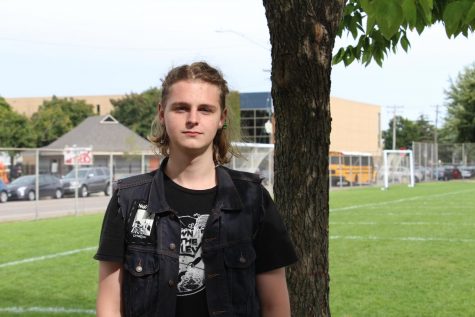Litter and needles and bodies, oh my! The neglect of the Minneapolis Greenway
On the side of The Greenway’s path under the Cedar Avenue bridge and two hypodermic needles. While these are still inclosed in their sterile packaging and removed from the trail, many bikers have had bad interactions with used or open needles lying on the path. “[The City] actually put up a box to put the needles in, but it’s not getting used. I popped my front and rear tires on needles,” said junior Ryder Nye.
December 17, 2019
The Greenway is a 5.5 mile long bike/walking trail stretching from Bde Maka Ska all the way to Dinkytown. You can get almost anywhere in the city using The Greenway, which is important because it offers bikers and walkers refuge from cars and traffic, one of the largest causes of fatalities and injuries for bikers.
The Greenway was at first a train corridor, but in the late 90’s the Midtown Greenway Coalition was formed, a grassroots non-profit looking to make the city safer for cyclists. Then in 2000 phase one of construction began.
According to an article by Minnpost, 95 pedestrians are injured or killed on Minneapolis streets annually. The Greenway (though some accidents are inevitable) greatly reduces the risk for bikers and walkers from the dangers of cars.
“I use the greenway pretty regularly, like a couple times a month,” said 11th grader Jay Manolis. “[The Greenway is important] because it’s a place where [bikers] can ride our bikes without having to worry about cars or stopping (for the most part).”
Lately, however, The Greenway seems to be largely neglected by the city. As you walk the path, you see bike parts, bottles, syringes, and other trash lying everywhere. You see people sleeping under bridges and in tents, and drug use is prominent.
“If you go West there’s a lot of homeless people on the side [of The Greenway], and just a ton of stuff in the path,” said Senior Julian Brandon. “There’s like gravel, and just trash everywhere. I saw a guy shooting up right on the path.”
Recently the issue of squatters on the Greenway has been much more apparent, with people sleeping under almost every bridge. While most just keep to themselves, there have been multiple instances of unprovoked violence on cyclists.
“This summer, a friend of mine got mugged on The Greenway. They stole his clothes and shoes. He carries a taser now,” said Ryder Nye, a junior. “People try to stop you and be like ‘hey can I have some money?’ then take your bike. I think my friend’s dad got bricks thrown at him or something.”
While The Greenway in its current state may be an eyesore, and can make traveling uncomfortable, it’s important to understand that this is the state of the city. Just like last years encampment, it is a visual that demonstrates the real issue of homlessness and drug dependency.
It’s not necessarily that the Twin Cities has more homeless people, but the large concentration of homeless people in one area gives you an idea as to the scale of the issue.
“From what I understand,” said Nye, “most of [the homeless people] came from the other homeless encampment. Not everyone moved into the housing, so a lot of them moved further down Hiawatha. With all the forest and stuff [on The Greenway] it’s not super travelled, and unlike the highway not everyone is staring at them and they can be alone.”
The city has made limited effort to improve the condition of The Greenway, but to no avail. “[The City] actually put up a box to put the needles in, but it’s not getting used. I popped my front and rear tires on needles,” said Nye.
While The Greenway is still a valuable part of the city, many feel that what should be a source of pride for the one of the top cities in the U.S. for bikers has deteriorated. Nye described the craziest thing he’s ever witnessed on The Greenway: “[I saw] a dead body being pulled out of a tent. This was at the beginning of the school year. He probably overdosed and had been in there for a good two weeks, in the hot sun,” he said. ¨I was a good 50 feet away [when emergency responders pulled him out] but you could just smell it coming out of the tent, there was this brown liquid, it was horrible.” Seeing officers pull a dead body from a tent in a public space can feel like a glimpse into how the city may be disregarding those in need of help.

![On the side of The Greenway’s path under the Cedar Avenue bridge and two hypodermic needles. While these are still inclosed in their sterile packaging and removed from the trail, many bikers have had bad interactions with used or open needles lying on the path. “[The City] actually put up a box to put the needles in, but it’s not getting used. I popped my front and rear tires on needles,” said junior Ryder Nye.](https://www.shsoutherner.net/wp-content/uploads/2019/12/Greenwayispoopoo.jpg)




